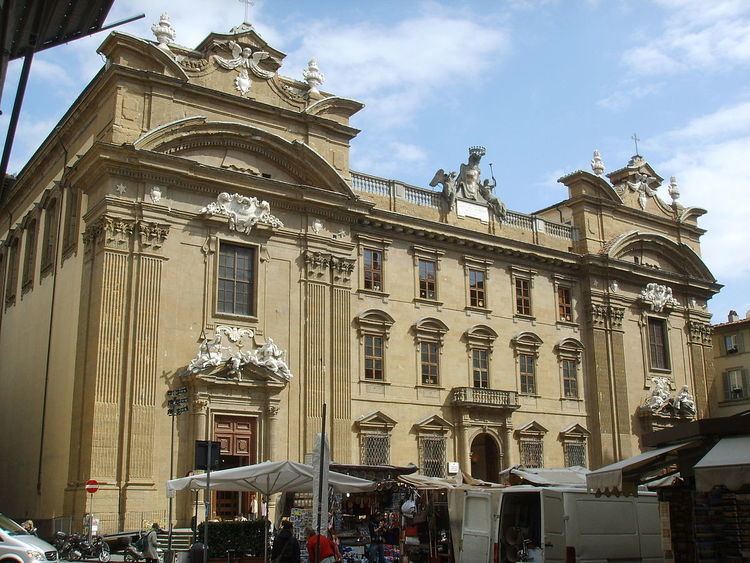 | ||
The Complesso di San Firenze (Complex of San Firenze) is a 17th-century Baroque-style building, consisting of a church, palace, and former oratory, located on the southeast corner of the saucer-shaped piazza of San Firenze, located in the quartiere of Santa Croce in central Florence, region of Tuscany, Italy. The buildings were commissioned by the Oratorians of Saint Philip Neri.
Contents
History
Prior to the 17th-century, paintings of the Piazza depict a drab 12th-century Romanesque brick church of San Florenzio hemmed by tall medieval houses. In 1645 Oratorians acquired in the 1640s the church and commissioned plans from Pier Francesco Silvani to construct an oratory. Construction began in 1645 with the attendance of the Grand-Duke, and Cardinal Carlo de Medici.
Once the oratory was completed in 1648, the oratorians received a further endowment from the son of Senator Giuliano de' Serragli, who commissioned an additional church from the famedBaroque architect Pietro da Cortona. The grandiose design of Cortona with two parallel flanking rectangular facades called for the acquisition of other buildings in the square.
The plan was reformulated over time, and by 1715 construction of the new church facade was completed by Ferdinando Ruggieri. The matching oratory facade was built from 1772 to 1775 by Zanobi Del Rosso. Others involved in the designs and construction were Gioacchino Fortini and Filippo Ciocchi.
This led to the present nearly symmetric arrangement of the church on the north wing, the former seminary and housing in the center, and the oratory on the south wing. In 1848, the church was rededicated to the Immaculate Conception and Phillip Neri.
With the suppression of the Oratorians, the Seminary has undergone a number of transitions. The Oratorion seminary was suppressed transiently in 1769, re-suppressed in 1808, but again returned to the order in 1814. By 1866, when Florence had been chosen the capital of Italy, the building was requisitioned by the state for office space. Restructuring and expansion of the seminary was conducted by Marco Treves and Paolo Comotto.
The entire building suffered damage during the 1966 floods. In 2015, it housed civil courts of Florence, but was used for other functions. The Oratory is used for events and concerts, while the church retains its original function.
Interior decoration
The interior has a ceiling with a canvas depicting the Glory of San Filippo Neri by Bonechi. The interior has elaborate and costly stucco work completed between 1668 and 1673 by a team of artists.
The Chapel of the Madonna has a Virgin by Carlo Maratta and an Eleven thousand Martyrs by Stradanus, which had been in the earlier church of San Firenze. The chapel was designed by The cupola has frescoes by Luigi Sabatelli. The chapel was designed by Zanobi del Rosso, and once had a canvas attributed to Francesco Bacchiacca.
The apse and altars of the church were designed by Fortini. He also completed the statues in the presbytery of Charity and Purity, and the bas-reliefs of the Life of St Phillip. Other works are by Antonio Montauti. Other paintings in the church are by Giovanni Pinzani, Tommaso Redi, Antonio Puglieschi, Anton Domenico Gabbiani, S and G Perini. The ceiling of the oratory, designed by Silvani has a canvas of Giovanni Camillo Sagrestani depicting the Glory of St Phillip. The apse has a large fresco depicting the Trinity with Apostles and Florentine Saints, by Niccolò Lapi.
